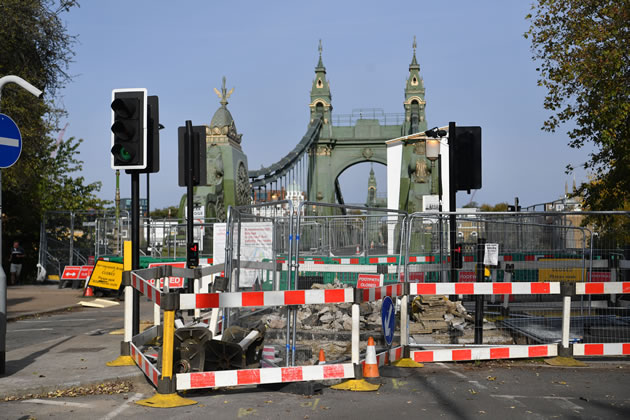Early Reopening of Hammersmith Bridge To Pedestrians Ruled Out
Council's engineers dismiss notion that stabilisation work not needed

Engineers hired by Hammersmith and Fulham Council have indicated that Hammersmith Bridge should remain fully closed until costly stabilisation works have been completed.
A report by Mott McDonald, released this Thursday (14 January), also says the extent of the damage to its four cast iron pedestals is not yet fully known and requires further investigation.
It is the latest twist in a war of words between the council and the Department for Transport (DfT) over what should be done with the bridge.
Much of the disagreement boils down to who will pay what share of the estimated £141 million repair bill, which includes £40 million of stabilisation works.
In December, the DfT released evidence from its own engineers, AECOM and Professor Normal Fleck, and claimed stabilisation may not be necessary to allow pedestrians and cyclists to use the crossing.
The 134-year-old, grade II*-listed landmark was closed to pedestrians and cyclists in August during a heatwave that saw its iron pedestals deteriorate further. Cars and buses were barred in April 2019 when cracks were first discovered.
A summary of Mott McDonald’s findings, seen by the Local Democracy Reporting Service, said: “The most recent MM report provides a good deal of evidence to suggest that the north-east pedestal is likely to be stable.
“However, that does not provide the degree of certainty required to reintroduce pedestrians in the short term because the necessary degree of independent checking has not been applied…
“Amid the plethora of detail there is the simple position that [Hammersmith and Fulham Council] H&F, AECOM and Prof Norman Fleck all agree upon – remedial works must be undertaken to restore any meaningful use of the bridge.”
Mott McDonald also said that a £420,000 temperature control system, installed by the council, has been successful at limiting the risk of “seizing” and further cracking in the north east pedestal.
It explains: “The temperature control system is currently set at a target temperature of 13.5C.
“This should be adjusted… to match the average of the newly derived maximum (high) and minimum (low) seizing temperature of 24C and -2C, respectively (i.e. 11C target temperature).”
Looking ahead, the report then says the bridge’s other pedestals still require further investigation.
It said, “H&F must bear in mind that the safety of the bridge depends on one brittle cast iron pedestal known to contain cracks which have shown movement, one which does not, and two others, still with paint needing removal, but known to contain some cracks that are of unknown condition. Those two pedestals must be investigated fully before consideration is given to any changes although unknowns will remain even then.”
It goes on, “It is obvious, and intuitive, to any member of the public that even with detailed knowledge of all the pedestals… the case is clearly for no use of the bridge without remedial works.”
Councillor Wesley Harcourt, H&F’s cabinet member for the environment, said, “We now need to move at pace to deliver on the further investigations and stabilisation work required.
“As we have suggested since closing the bridge on public safety grounds in August, there is a clear route towards the bridge being re-opened for pedestrians and cyclists within a year provided the necessary programme of stabilisation works is agreed.”
Meanwhile, a TfL spokesperson confirmed this week that it is in the process of hiring a company to provide the ferry crossing for school children.
A schedule for when the service could be operational has yet to be confirmed, although officers are still aiming for a date in the spring.
The bridge Task Force is expected to resume its regular meetings this month.
A DfT spokesperson said, “Once we receive the full report, we look forward to further discussions between our engineers. We are committed to ensuring Londoners can cross the river again as soon as it is safe to do so.”
Owen Sheppard - Local Democracy Reporter
January 15, 2021